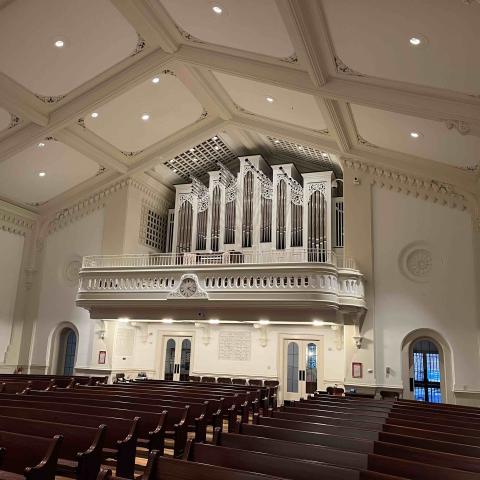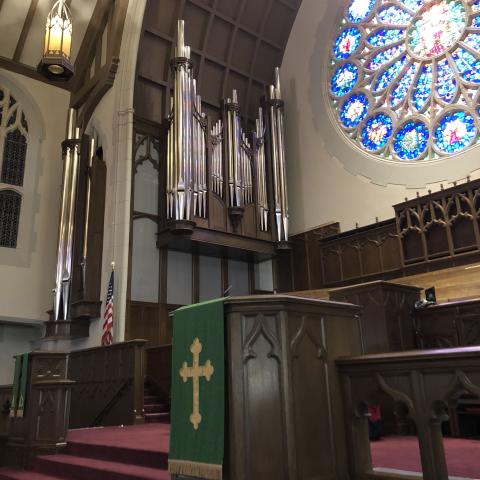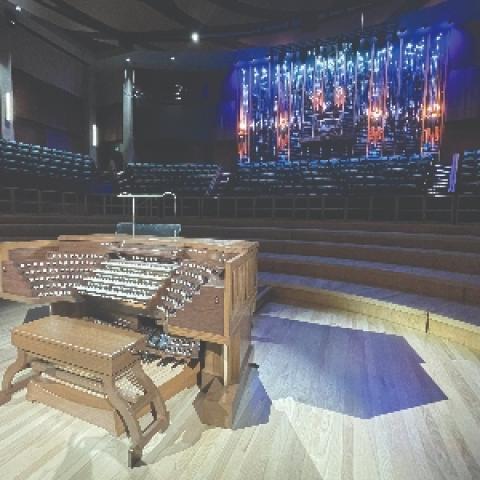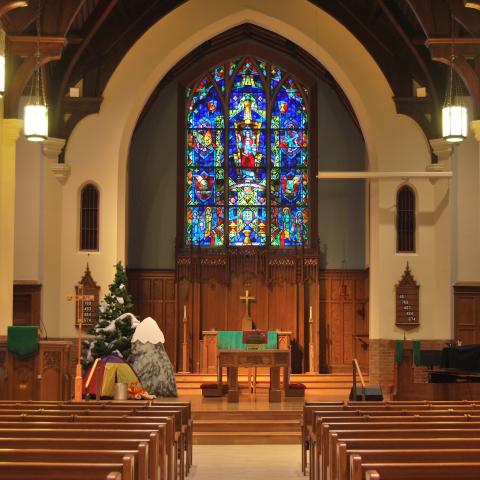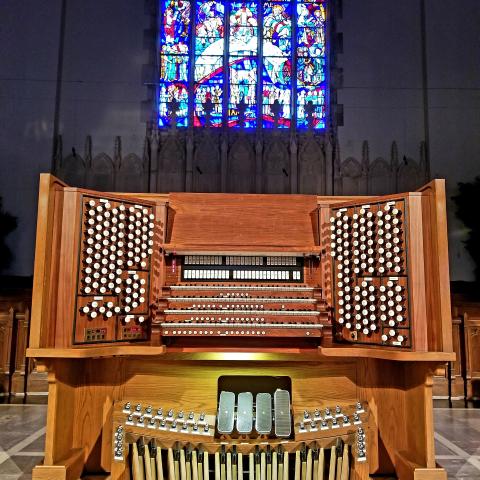Létourneau Pipe Organs, St-Hyacinthe, Québec, Canada; Gloria Dei Lutheran Church, St. Paul, Minnesota

Gloria Dei Lutheran Church is a large, welcoming ELCA congregation founded in 1908. Serving the Highland Park neighborhood of St. Paul, the church opened its present sanctuary in 1952 with subsequent additions to the church complex to accommodate the congregation’s growth and needs. An unusually active congregation, Gloria Dei undertakes its outreach and social justice ministries enthusiastically through various environmental, housing, hunger, and advocacy initiatives.
The pipe organ from Gloria Dei’s previous church building served the new sanctuary until it was replaced in 1962 by M. P. Möller’s Opus 9864. A three-manual instrument, the Möller employed significant unification throughout its modest specification, making the very most of its 36 ranks. The small and oddly shaped organ chamber dictated that the Möller had to be shoehorned in to a rarely seen degree. With chamber openings along one side of the chancel, most organ tone passed laterally across the chancel where it was then reflected off the opposite wall and dispersed out to the nave—but not before first passing through the deep chancel arch. As a result, the Möller was barely adequate for its many roles and was augmented in 1975 with the addition of an eight-rank Antiphonal division high on the back wall of the sanctuary, again by M. P. Möller.
After more than five decades of service, the Möller’s electro-pneumatic windchests were exhibiting typical signs of wear and leather failure, but the cramped organ chamber made chest repairs unreasonably difficult and costly. Cleverly, a unit chest was set up as an interim solution at the back of the Swell division to serve as a catchall for dead note actions as they came up. Pipes whose actions had failed were plucked from their original chests, reset on the unit chest at the back of the chamber, and the unit chest wired accordingly to the switching system.
The accelerating frequency of problems with the Möller was a serious issue, but the organ’s compromised location meant that a complete restoration—or even an all-new instrument in the same chamber—would not provide the improvement Gloria Dei was seeking. As part of their deliberations, the Gloria Dei organ committee looked carefully at all options as far as the organ’s placement and soon determined that the organ should go across the front wall of the chancel. Exceptionally, the organ committee’s discernment process blossomed into a larger sanctuary renewal campaign entitled “Rise, O Church.” In the words of Pastor Bradley Schmeling, “Rise, O Church is more than just buying a new organ or doing some remodeling. It’s about our dedication to be a growing, vibrant congregation ready to meet the needs of future generations and our neighboring community.”
In the meantime, Létourneau had been advertising a 1959 Casavant Frères pipe organ that the company had rescued from a closed church in Toronto, Ontario. The advertisement proposed completing the Casavant’s specification with several new stops, and this caught the attention of Gloria Dei’s organ consultant, Gregory Peterson, then of Luther College, and Tim Strand, Gloria Dei’s director of music.
The Casavant was an early instrument in Lawrence Phelps’s tenure as tonal director and displayed some of the first steps in the profound and rapid change of style Phelps oversaw in Casavant Frères organs. Vestiges from the era predating Phelps include the 16′ Flûte conique and the 8′ Aeoline stops in the Swell plus an augmented Pedal division. On the other hand, the Choir 4′ Koppelflöte, the organ’s narrow-scaled reed stops with parallel shallots, the generally thin-walled pipework, and the boldly scaled upperwork were examples of Phelps’s emerging aesthetic. As the Casavant featured no casework or façade pipes, our advertisement also offered new casework with façade pipes for the expanded instrument.
With the Casavant’s 34-rank specification as a starting point, we expanded the instrument with eighteen additional ranks to complete each of the instrument’s four divisions. To the Great division, we added a 16′ Contra Geigen stop and a soaring 8′ Flûte harmonique, as well as trumpet stops at 8′ and 4′ pitches. The Swell division was already largely complete; the only changes were the replacement of the 8′ Aeoline with a proper 4′ Principal stop and the addition of a new 16′ Bombarde stop with full-length resonators scaled to match the 8′ Trompette and 4′ Clairon.
Devised in an era when Positiv divisions were coming into fashion, the original Choir division was judged to be short on 8′ foundation tone. The addition of new 8′ Geigen Principal and 4′ Geigen Octave stops addressed this point, as well as the new undulating rank to go with the 8′ Spitzflöte. A new three-rank Sharp mixture completes the Choir’s principal chorus, offering more brilliance than its counterparts in the Swell. To augment the existing Swell 8′ Oboe and Choir 8′ Clarinet stops, we added a delicate 8′ Cor anglais as a third solo reed option.
The Pedal division was built on a rich-toned 16′ Contrabass stop in zinc, though it was originally extended to play at 8′ and 4′ pitches. The original 8′ extension of the 16′ Subbass rank was maintained, but new 8′ Principal and 4′ Choral Bass ranks plus a three-rank mixture were added to provide a true pedal chorus. Bold reed stops at 16′ and 8′ were also added to give the Pedal the necessary grandeur and color.
The Casavant electro-pneumatic windchests in solid mahogany were restored in our workshops, with new electro-pneumatic chests provided as needed. The original chests’ 68-note compass was retained and carried over into the new windchests as well. The organ’s painted casework was designed by Claude Demers and was constructed from maple; it features polished pipework in 70% tin from the Great 16′ Contra Geigen, the Great 8′ Principal, and the Pedal 8′ Principal ranks.
The eight-rank Antiphonal division and its 8′ Trompette en chamade with polished brass resonators were retained as part of the project for added support from the rear of the nave. The Möller electro-pneumatic windchests were restored, while the Antiphonal’s wind system was rebuilt to incorporate a new blower.
The instrument is played from a new three-manual console with the shell made from rift sawn red oak and the interior panels in walnut. Built to be as compact as possible for good sightlines, the console offers organists 999 levels of memory, twelve General pistons with sequencer, a sostenuto effect for each manual, a Great-Choir Manual Transfer feature, and a Pedal Divide coupler. Numeric displays showing the positions of the Swell and Choir’s expression shades are included, as is Solid State Organ System’s Organist Palette. An iPad-controlled suite of features, the palette includes a wireless record-playback interface, visual management of the General piston sequencer, a transposer, and control of the various sostenutos and the Pedal Divide coupler.
The organ was delivered to the church in late October of 2022 and was installed in collaboration with the Organ Clearing House. The voicing of the instrument commenced after Thanksgiving with the welcome participation of Jonathan Ortloff for several weeks, and the project was wrapped up in the New Year.
Létourneau’s Opus 137 was played by Tim Strand in its first solo concert on April 23, 2023. Seminal works by Cook, Bach, Duruflé, and Vierne were heard by a large and especially enthusiastic crowd, as were the world premieres of two new pieces. The first, Partita on “Rise O Church, like Christ Arisen” by David Cherwien, is based on the hymn of the same name, tune Surge Ecclesia (written by Mr. Strand), and featuring words written by Dr. Chewien’s late wife Susan. The second work was a rich new setting of the Swedish tune “The Earth Adorned in Verdant Robe” for saxophone and organ by Robert Buckley Farlee, with Kurt Claussen playing the soprano saxophone.
Many people played important roles—some visible, some less so—in helping us and Gloria Dei Lutheran Church realize this organ project. We would like to thank Tim Strand, Gregory Peterson, Pastor Bradley Schmeling, Mike Kruger (chair of Gloria Dei’s Sanctuary Renewal Task Force), Teresa Sterns (project manager for Gloria Dei), Todd Kraft and Sara Du of HGA Architects, the team at Langer Construction, the Organ Clearing House, and the Ortloff Organ Company.
—Létourneau Pipe Organs
Photo credit: Andrew Forrest
GREAT – Manual II
16′ Contra Geigen 68 pipes new, 70% tin
8′ Principal 68 pipes new, 70% tin
8′ Harmonic Flute 68 pipes new, 56% tin
8′ Gemshorn 68 pipes Casavant Frères pipework
8′ Bourdon 68 pipes Casavant Frères pipework
4′ Octave 68 pipes Casavant Frères pipework
4′ Rohrflöte 68 pipes Casavant Frères pipework
2-2⁄3′ Twelfth 61 pipes Casavant Frères pipework
2′ Fifteenth 61 pipes Casavant Frères pipework
1-1⁄3′ Mixture IV 244 pipes Casavant Frères pipework
8′ Trumpet 68 pipes new, 56% tin
4′ Clarion 68 pipes new, 56% tin
Great 16′ - Great Unison Off - Great 4′
8′ Trompette en chamade 61 pipes M. P. Möller pipework (with Antiphonal)
Zimbelstern
SWELL (enclosed) – Manual III
16′ Flûte conique 68 pipes Casavant Frères pipework
8′ Viole de gambe 68 pipes Casavant Frères pipework
8′ Voix Celeste 61 pipes from g8, Casavant Frères pipework
8′ Rohrflöte 68 pipes Casavant Frères pipework
4′ Principal 68 pipes new, 56% tin
4′ Nachthorn 68 pipes Casavant Frères pipework
2′ Piccolo 61 pipes Casavant Frères pipework
2′ Mixture III 183 pipes Casavant Frères pipework
16′ Bombarde 68 pipes new, 56% tin
8′ Trompette 68 pipes Casavant Frères pipework
8′ Oboe 68 pipes Casavant Frères pipework, new shallots
4′ Clairon 68 pipes Casavant Frères pipework
Tremulant
Swell 16′ - Swell Unison Off - Swell 4′
CHOIR (enclosed) – Manual I
8′ Geigen Diapason 68 pipes new, 56% tin
8′ Gedackt 68 pipes Casavant Frères pipework
8′ Spitzflöte 68 pipes Casavant Frères pipework
8′ Flute Celeste 61 pipes from g8, new, zinc and 56% tin
4′ Geigen Principal 68 pipes new, 56% tin
4′ Koppelflöte 68 pipes Casavant Frères pipework
2-2⁄3′ Nazard 61 pipes Casavant Frères pipework
2′ Flageolet 61 pipes Casavant Frères pipework
1-3⁄5′ Tierce 61 pipes Casavant Frères pipework
1′ Sharp Mixture III 183 pipes new, 56% tin
8′ Clarinet 68 pipes Casavant Frères pipework
8′ Cor anglais 68 pipes new, zinc and 56% tin
Tremulant
Choir 16′ - Choir Unison Off - Choir 4′
16′ Trompette en chamade (TC) from Great
8′ Trompette en chamade from Great
ANTIPHONAL – floating
8′ Spitz Principal 61 pipes M. P. Möller pipework
4′ Octave 61 pipes M. P. Möller pipework
4′ Gedackt 61 pipes M. P. Möller pipework
2′ Super Octave 61 pipes M. P. Möller pipework
1′ Mixture III 183 pipes M. P. Möller pipework
PEDAL
32′ Resultant derived
16′ Contrabass 32 pipes Casavant Frères pipework
16′ Geigen from Great
16′ Spitz Principal 12 pipes extension of Antiphonal 8′ Spitz Principal
16′ Subbass 32 pipes Casavant Frères pipework
16′ Flûte conique from Swell
8′ Principal 32 pipes new, 70% tin
8′ Bass Flute 12 pipes extension of 16′ Subbass
8′ Flûte conique from Swell
4′ Choral Bass 32 pipes new, 56% tin
2-2⁄3′ Mixture III 96 pipes new, 56% tin
16′ Trombone 32 pipes new, 56% tin
16′ Bombarde from Swell
8′ Trumpet 32 pipes new, 56% tin
8′ Trompette en chamade from Great
4′ Trompette en chamade from Great
Intermanual Couplers
Great to Pedal
Great 4′ to Pedal
Swell to Pedal
Swell 4′ to Pedal
Choir to Pedal
Choir 4′ to Pedal
Antiphonal to Pedal
Swell 16′ to Great
Swell to Great
Swell 4′ to Great
Choir 16′ to Great
Choir to Great
Choir 4′ to Great
Antiphonal to Great
Swell 16′ to Choir
Swell to Choir
Swell 4′ to Choir
Great to Choir
Antiphonal to Choir
Choir to Swell
Antiphonal to Swell
59 stops, 60 ranks, 3,591 pipes
Mixture Compositions
Great Mixture IV
c1 to b12 19 22 26 29
c13 to b24 15 19 22 26
c25 to f42 12 15 19 22
f#43 to b48 8 12 15 19
c49 to c61 1 8 12 15
Swell Mixture III
c1 to f18 15 19 22
f#19 to f30 12 15 19
f#31 to f54 8 12 15
f#55 to c61 1 8 12
Choir Sharp Mixture III
c1 to d#16 22 26 29
e17 to d27 19 22 26
d#28 to c#38 15 19 22
d39 to c49 12 15 19
c#50 to c61 8 12 15
Antiphonal Mixture III
c1 to f18 22 26 29
f#19 to c37 19 22 26
c#38 to c49 15 19 22
c#50 to e53 12 15 19
f54 to c61 8 12 15
Pedal Mixture III
c1 to g32 19 22 26
Builder website: www.letourneauorgans.com
Church website: www.gloriadeistpaul.org

